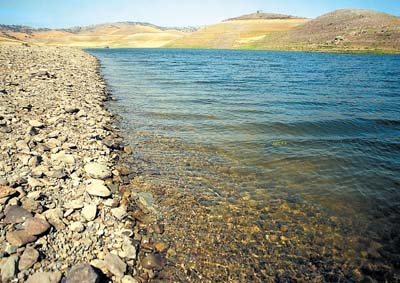A federal judge has temporarily lifted pumping curbs designed to
protect salmon migration in the Sacramento-San Joaquin River Delta,
an action that allows the diversion of more winter storm flows to
the San Luis Reservoir and to farms and cities in the south.
By Bettina Boxall
A federal judge has temporarily lifted pumping curbs designed to protect salmon migration in the Sacramento-San Joaquin River Delta, an action that allows the diversion of more winter storm flows to the San Luis Reservoir and to farms and cities in the south.
Friday’s ruling is the latest in a tortuous legal fight over Endangered Species Act protections that limit pumping from the troubled delta east of San Francisco, a source of water for 23 million Californians and millions of acres of farmland.
The decision was a victory, however brief, for San Joaquin Valley irrigation districts that have tried in the courts and the halls of Congress to loosen pumping restraints that have reduced their water deliveries.
Ironically, the ruling was issued by U.S. District Judge Oliver Wanger, whose earlier decisions forced the federal government to strengthen protections for the delta’s collapsing fisheries.
Wanger issued a 14-day restraining order, lifting curbs designed to keep migrating Chinook salmon away from the giant pumps that suck water from the south delta.
He concluded that the additional pumping would not seriously harm the young winter-run salmon moving through the delta to the sea, whereas reduced diversions were significantly hurting agricultural and urban water supplies.
“It is undisputed that every acre-foot of pumping that is foregone during this time of year is an acre-foot that does not reach the San Luis Reservoir where it can be stored for future delivery to users during times of peak demand later in the water year,” Wanger wrote.
But his decision sent mixed signals about the ultimate outcome of the case. He found that plaintiffs “have not yet established a likelihood of success” on their claims against the Endangered Species Act.
Instead, Wanger ruled that the U.S. Bureau of Reclamation had not performed the necessary analysis of the pumping permit and its restrictions under another federal law, the National Environmental Policy Act.
“This is not a decision on the soundness of the [permit], the analysis included in it or the actions required by it,” said Chris Yates, a NOAA Fisheries Service assistant regional administrator. “We continue to stand by those conclusions very strongly.”
Maria Rea, director of the NOAA Fisheries Central Valley office, said the increased pumping would probably result in more salmon losses.
The San Luis & Delta-Mendota Water Authority and Westlands Water District, the nation’s biggest irrigation district, sought the injunction, along with the Metropolitan Water District of Southern California.
“I think it has much broader implications,” said Dan Nelson, executive director of the San Luis authority, which represents Central Valley irrigators. “I would hope the federal government would take a couple steps back and take another look” at the salmon permit as well as another designed to protect the delta smelt, which is nearing extinction.
Most of last year’s cuts in water deliveries were a result of the state drought, not the pumping curbs, according to government water managers.
But that has not stopped agriculture and Central Valley politicians from attacking the Endangered Species Act protections as the cause of economic hardship.
Commercial salmon fishermen, who have endured two closed seasons because of collapsing stocks, have shot back that without them, their entire way of life will disappear.










